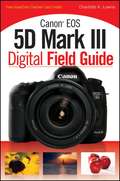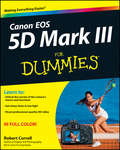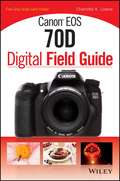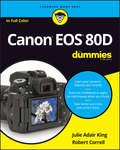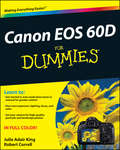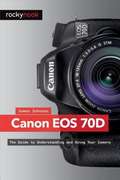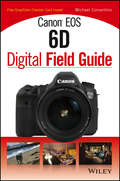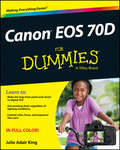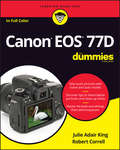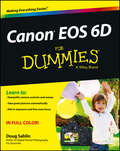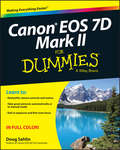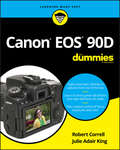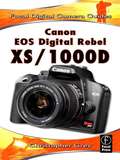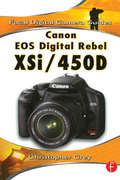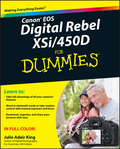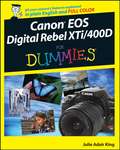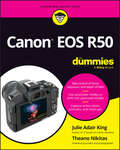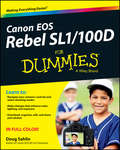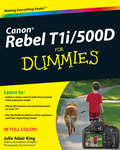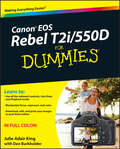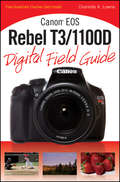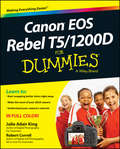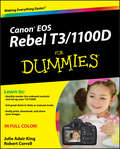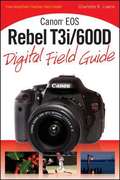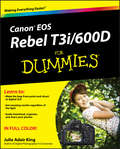- Table View
- List View
Canon EOS 5D Mark III Digital Field Guide
by Charlotte K. LowrieGuides you step-by-step through the functions on your new Canon EOS 5D Mark III dSLR cameraThe Canon EOS 5D Mark III full-frame dSLR camera features an impressive 22.3 megapixels, a 3.2-inch LCD screen, 6 fps continuous shooting, Live View, an ISO range of 50 to 102,400 and full HD 1080 resolution movie shooting. Here to help you get the most out of these remarkable features and offering you more in-depth coverage than the standard manual, this full-color Canon 5D Mark III Digital Field Guide provides you with guidance on how and when to use each button, dial, and menu option. Delivering information in an easy-to-understand format, this portable guide features more than 200 inspirational photos by acclaimed photographer and veteran author Charlotte Lowrie. The handy trim size allows this guide to go where you go, providing you with easy access to information quickly so you can get the exact shot you want when you want it.Helps you make the most of your Canon EOS 5D Mark III and get the shots you wantOffers full detailed coverage of when and how to use each and every button, dial, and menu option on this sophisticated new dSLRProvides step-by-step explanations on techniques and tips, all aimed at getting you comfortable and confident with your new Canon 5D Mark III Sized to fit in a camera bag, the book includes a bonus gray and color checker card to help you capture perfect white balance and color every time. Ideal reading for both amateur and professional photographers alike, you'll reference Canon 5D Mark III Digital Field Guide again and again.
Canon EOS 5D Mark III For Dummies
by Robert CorrellThe ideal reference to Canon's EOS 5D Mark III for professionals and serious hobbyistsThe Canon EOS 5D Mark III offers professional photographers and advanced amateurs a wide range of top-flight dSLR capabilities. Canon users love For Dummies guides, with more than 100,000 copies of previous Canon camera guides sold. Like its predecessors, this one is packed with colorful examples that illustrate camera features and inspire you to capture your own super images. It explains the camera controls and menus, shows you how to take full advantage of all the features, discusses output options and image editing, and much more.Geared to the needs of professional dSLR photographers and serious hobbyists, this guide covers all the features of the Canon EOS 5D Mark IIIExplores the camera body, menu screen, auto settings, and image settingsShows how to use the video modes, priority settings, manual settings, and focus modes to capture the best imagesProvides suggestions and inspiration with more than 300 full-color photosCovers image editing and output optionsFeatures tips, techniques, and projects to help you get the most from your camera's capabilitiesCanon EOS 5D Mark III For Dummies is the perfect partner for your new dSLR.
Canon EOS 60D Digital Field Guide
by Charlotte K. LowrieWith18.0 megapixels, full high definition recording capabilities, broad range ISO settings, shutter speed up to 5.3 frames per second, and many other advanced features, the Canon EOS 60D is a solid intermediate dSLR. The Canon EOS 60D Digital Field Guide will teach you how to get the most out of these impressive features.Chapter 1: Roadmap to the 60D. - Learn the basics of camera and lens controls, as well as menu navigation and viewfinder displays on your Canon EOS 60D.Chapter 2: Choosing Camera Options and Reviewing Images. - Learn which format and image quality settings are best for each situation, and how to modify key settings on the Canon EOS 60D to get the best quality images.Chapter 3: Getting Great Exposures and Focus. - Learn all the automatic, manual, and sensitivity settings needed to get the most out of your Canon EOS 60D's imaging capabilities in any lighting situation or for any subject near or far.Chapter 4: Using Color Options, Ambience, Effects, and Creative Filters. - Learn how to improve your photography by use of color space, white balance, and filters by adjusting the setting on your Canon EOS 60D.Chapter 5: Customizing the 60D. - Learn all of the customization options for the Canon EOS 60D including exposure, images, auto focus, and menu settings to make your camera work for you.Chapter 6: Shooting in Live View Mode. - Learn the pros and cons of live view shooting, as well as the best settings and tips for working in your Canon EOS 60D's live view mode.Chapter 7: Using Movie Mode. - Learn how to record video on the Canon EOS 60D and get tips for video standards, optimal camera settings, and editing.Chapter 8: Working with Flash. - Learn how to use and modify the Canon EOS 60D's built in flash, and learn to shoot with wireless Speedlites and other flash techniques to bring professional quality photography to your fingertips.Chapter 9: Lenses and Accessories. - Learn all you need to know for choosing the optimal lenses for the Canon EOS 60D, including lens types, focal-length multipliers, and lens accessories. Also learn how to work with multiple lens types for optimal photos in any situation.Chapter 10: Event and Action Photography. - Learn the optimal settings and gear needed to shoot great action photographs with the Canon EOS 60D including set up options and a gear selection guide.Chapter 11: Nature and Landscape Photography. - Learn how to capture stunning natural images and landscapes using your Canon EOS 60D, as well as how to choose the proper gear for nature and landscape photography.Chapter 12: Portrait Photography. - Learn how to make natural light and studio quality portraits with the Canon EOS 60D including guides on gear selection, lighting, and exposure.Appendix A: The Elements of Exposure. - Learn or review the fundamentals of exposure and how they relate to your Canon EOS 60D's settings.Appendix B: Exploring RAW Capture. - Learn the elements of RAW capture as well as a brief walk-through on converting RAW images into a final image.Appendix C: How to Use the Grey Card and Color Checker. - Learn how to produce photos with accurate color and exposure with these free-inside-the-book tools.A full color, portable trim book with beautiful photography for photographers on the go, the Canon EOS 60D Digital Field Guide includes a free grey/color checker card to help you achieve accurate white balance and color. With the Canon EOS 60D Digital Field Guide, you will gain a thorough understanding of the Canon EOS 60D camera, as well as the basic fundamentals of capturing the best possible photos.
Canon EOS 60D For Dummies
by Julie Adair King Robert CorrellA full-color guide to all the bells and whistles in your new Canon 60DIf you own a Canon 60D, you?ve got a camera for advanced amateurs and one that?s very close to professional-level equipment. Now it?s time to make sure you get the very most out of all that power. Julie Adair King teams up with Robert Correll to help digital camera users catch their skills up to what their cameras have to offer in this fun but thorough guide. Understand all your camera?s features, move beyond the security blanket of Auto mode, and start capturing the pictures you?ve dreamed of. Gives you the full picture on Canon?s EOS 60D dSLR camera, in the friendly, easy-to-follow, For Dummies styleHelps you explore the 18-mexapixel sensor, full HD video recording, a tilt-view LCD, and expanded in-camera editing tools and filtersTeaches you tricks and techniques, with over 300 example photos and menu captures in full colorReveals how to adjust settings for optimal exposure, lighting, focus, and colorGives you ten top tips on photo editingThe Canon 60D dSLR camera, the expertise of Julie Adair King and Robert Correll, and your own, untapped ability?all you need now is the book! Canon EOS 60D For Dummies.
Canon EOS 60D For Dummies
by Julie Adair King Robert CorrellA full-color guide to all the bells and whistles in your new Canon 60D If you own a Canon 60D, you?ve got a camera for advanced amateurs and one that?s very close to professional-level equipment. Now it?s time to make sure you get the very most out of all that power. Julie Adair King teams up with Robert Correll to help digital camera users catch their skills up to what their cameras have to offer in this fun but thorough guide. Understand all your camera?s features, move beyond the security blanket of Auto mode, and start capturing the pictures you?ve dreamed of. Gives you the full picture on Canon?s EOS 60D dSLR camera, in the friendly, easy-to-follow, For Dummies style Helps you explore the 18-mexapixel sensor, full HD video recording, a tilt-view LCD, and expanded in-camera editing tools and filters Teaches you tricks and techniques, with over 300 example photos and menu captures in full color Reveals how to adjust settings for optimal exposure, lighting, focus, and color Gives you ten top tips on photo editing The Canon 60D dSLR camera, the expertise of Julie Adair King and Robert Correll, and your own, untapped ability?all you need now is the book! Canon EOS 60D For Dummies.
Canon EOS 6D
by James JohnsonThe Canon EOS 6D is the latest of Canon's full-frame DSLR cameras. Its impressive array of advanced capabilities allows the photographer more influence over the final image. This book's exploration of the EOS 6D goes beyond that of the user's manual. It provides illustrations, step-by-step setting adjustments, helpful suggestions for setup, and detailed explanations for each of the camera's many features and menu configurations. The text is illustrated with easy-to-follow screenshots and example images. This book will also introduce intermediate-level camera users to DSLR model-differentiating features: built-in GPS and Wi-Fi. The content covers effective use of the camera's hardware (and some software) as well as certain related accessories, with little emphasis on general photography. Author James Johnson covers everything from basic camera features to advanced photographic options. With this book as your guide, you'll learn to successfully use this powerful camera.
Canon EOS 6D Digital Field Guide (Digital Field Guide #265)
by Michael CorsentinoThe Canon EOS 6D is Canon's smallest and lightest full-frame DSLR camera to date and boasts an extensive feature set. This full-color, portable guide goes beyond the owner's manual to deliver clear, succinct descriptions of how these features and functions work and explains how they affect the resulting photos. With the expert advice and clear instructions, the Canon EOS 6D Digital Field Guide makes this sophisticated camera accessible to even first-time DSLR users Helps you to consistently achieve professional-level photography using the Canon EOS 6D Walks you through the essential controls, features, and functions using step-by-step instructions and providing full-color images of each menu screen Shows you how to get the exact shots you want, when you want them, and is packed with beautiful color photos Shoot in Live View, choose the best settings for movie-making, and learn how to share your images and video online via the built-in Wi-Fi Includes step-by-step techniques and professional tips on taking exceptional photos with your Canon EOS 6D Canon EOS 6D Digital Field Guide is packed with so much helpful advice for getting the most out of your Canon EOS 6D, you'll find yourself referencing it again and again
Canon EOS 70D For Dummies
by Julie Adair KingStart getting great photos with your Canon EOS 70D right awayThe Canon EOS 70D features upgraded focusing technology, a 20.2 megapixel sensor, and faster frame-per-second shooting. Whether you're new to dSLR photography or just getting acquainted with the 70D, this handy, full-color guide will have you taking great photos before you know it. You'll learn to use all the on-board controls, shoot in auto mode, use live view, control exposure and lighting, manipulate focus and color, transfer your images to the computer for editing, and share the results in prints or online. Colorful photos throughout illustrate what you can achieve.Upgraded features in the Canon EOS 70D include a new focusing technology that speeds up autofocus for video and live view shooting, a larger sensor, faster frame-by-frame shooting, and a wider ISO rangeThis full-color guide explains how to take advantage of all the features; walks you through all the on-board controls, and shows how to shoot in auto modeCovers dSLR basics such as dialing in exposure and lighting controls, manipulating focus and color, and transferring your images from the camera to the computerOffers advice for shooting in various common situations and explains how to post your photos online, make prints, or share them in other waysCanon EOS 70D For Dummies makes it easy to get terrific photos with your Canon dSLR camera.
Canon EOS 77D For Dummies
by Julie Adair KingGet pro results from your 77D! The Canon EOS 77D puts features from higher-end cameras into a model designed for amateur photographers—and that's good news for you! Even better, Canon EOS 77D For Dummies makes it easier than ever to start producing pro-level photos. You'll start by getting a grasp on the mysterious terms that photographers throw around and then learn how your camera puts you in control of your image's exposure, color, and focus tools. Plus, you can follow some basic photography recipes to create portraits, nature shots, and action photos worth bragging about. If you're just getting your hands on your first DSLR camera, you're in for a photographer's delight! With the help of this friendly guide, you'll walk through all the steps of shooting in automatic, scene, or manual mode. Plus, the book is packed with full-color photos designed to explain and illustrate how the 77D can control the focus and color in an image—ensuring you'll get the perfect shot every time. Find simple steps for shooting better photos Learn the tricks the pros use to control exposure settings Discover how to capture better light and color Get tips for working with more advanced features Everything you need to take picture-perfect photos with your Canon EOS 77D is inside!
Canon EOS 7D For Dummies
by Doug SahlinGet the most out of the new Canon EOS 7D with this fun and friendly guideThe new Canon EOS 7D comes equipped with a huge 18.0 megapixel sensor, many beginner-friendly features to aid in getting great pictures, and a video mode that allows you to shoot video as well as stills. If you're looking to get the most from the features and functions that come with this dSLR, then this is the book for you!Written by a veteran author and experience photographer, this easy-to-understand guide shows you how to properly use all the capabilities of this new camera. Filled with page after page of full-color images, this book walks you through the features of the Canon EOS 7D and the software that accompanies it.Introduces you to the main features and functions of the new Canon EOS 7DExplains the on-board controls, shooting in auto mode, using live view and playback modes, and dialing in exposure and lighting controlsWalks you through manipulating focus and color controls and handling situational shootingAddresses getting photos onto a PC for editingPrepare to take aim at maximizing all the features and functions that the Canon EOS 7D has to offer with this helpful book by your side!
Canon EOS 7D Mark II For Dummies
by Doug SahlinGet great digital shots with your Canon EOS 7D Mark II This full-color guide to the features and functions of the Canon EOS 7D Mark II makes it easy for first-time users to get the most out of the camera and capture cool, professional-level photos. Packed with examples on how to create eye-popping digital photos, Canon EOS 7D Mark II For Dummies gives you a plain-English tour of the camera's controls, shows how to manipulate focus and color, gives step-by-step instructions on how to shoot better low-light and action shots, and so much more. Digital Single Lens Reflex (DSLR) cameras offer full control over exposure settings while also providing pre-sets and auto mode options for beginners. If you're just picking up--or considering buying--a Canon EOS 7D Mark II camera, this fun and friendly guide takes the intimidation out of making sense of the bells and whistles so you can get right down to snapping stunning photos. Covers shooting in auto mode and using live view and playback modes Explains how to dial in exposure and use lighting controls Includes easy tips for printing, posting photos online, and other ways to share images Gives you ten photo editing tricks and pro functions If you're an amateur photographer who wants better-than-entry-level gear, or a pro looking for a budget camera to add to your collection, Canon EOS 7D Mark II For Dummies has the information you need to get more bang for your buck out of this powerful camera.
Canon EOS 90D For Dummies
by Julie Adair King Robert CorrellGet excited about the Canon EOS 90D and all it can do! An amazing photo begins with a quality camera and the know-how to use it. If you’ve selected the Canon EOS 90D, you now have a digital camera that serves a range of photographers, from novices to professionals. It takes some know-how to take advantage of the camera’s upgrades to its sensor, shutter speed, and video capabilities. Fortunately, Canon EOS 90D For Dummies canhelp you maximize the potential of the camera and its features. Canon EOS 90D For Dummies lets you skip the photography class and start shooting high-quality images right away The book introduces the camera’s settings; explains how to take control of exposure, focus, and color; and shows how to put all this new-found knowledge to work to shoot great portraits or action shots. The book is co-written by a pair of photography pros who share their professional experience on how to apply simple techniques for great shots. Choose the best setting for your situation Manage focus and color Make the most of your lighting Understand camera settings Customize your camera to your needs Create remarkable photos and memories, whether you stick with user-friendly automatic settings or decide to dive into more advanced features. With your Canon EOS 90D and this book at your side, you can shoot quality video and capture moving subjects confidently.
Canon EOS Digital Rebel XS/1000D: Focal Digital Camera Guides
by Christopher GreyJust bought a Canon EOS Digital Rebel XS/1000D and looking to combine practical know-how with inspiration? This one-stop, easy-to-read guide covers all the basic functions of the camera, and everything beyond.Inside, you'll find detailed explanations of every control and every feature, including full-color illustrations showing how changing each setting will affect your photos. But this book's greatest strength isn't its focus on the camera; it's the detailed, easy-to-follow instruction it offers on using your camera to take superior photographs. The lens, the subject matter, the light-all these variables are covered in depth, and always in the context of the Canon EOS Digital Rebel XS/1000D.Written by a widely acclaimed photographer and teacher, Canon EOS Digital Rebel XS/1000D shows you how to get the shots you can see in your head but have never been able to capture with a camera..Get up and running in five minutes with the quick start guide.Master your camera's many features and controls.Profit from dozens of tips and tricks .See first-hand how different settings affect your photos.Refine and manage your photos using the Canon software.Be inspired by hundreds of gorgeous, full color photographs, and learn how to get the same effects in your own shots
Canon EOS Digital Rebel XSi/450D
by Christopher GreyFocal Digital Camera Guides: Canon EOS Digital Rebel XSi/450D Just bought a Canon EOS Digital Rebel XSi/450D and looking to combine practical know-how with inspiration? This one-stop, easy-to-read guide covers all the basic functions of the camera, and everything beyond.For the basics, turn to the quick start guide, which will get you up and running in five minutes.For an understanding of your camera's many controls and features, check out the section called "The Camera." If all you need is a quick explanation, you'll find it. If you're looking for the Whole Story, you'll find that, too. Settings that affect how your pictures look are accompanied by full-color examples that show you exactly what you can expect. This section also covers the camera's menus, playback features, memory, and power sources.The section called "Software" shows you how to get the most out of your camera's software. It covers tethered shooting, color management, RAW conversion, storing your images, managing your library, and backup strategies - to name just a few topics.Ultimately, this book's greatest strength isn't its focus on the camera or the software; it's the detailed, easy-to-follow instruction it offers on using your camera to take truly superior photographs. Sections devoted to lenses, subject matter, and light cover these variables in depth, always presenting the most effective techniques in the context of the strengths and limitations of the Canon EOS Digital Rebel XSi/450D. Written by a widely acclaimed photographer and photography teacher, Canon EOS Digital Rebel XSi/450D shows you how to get the shots you can see in your head but have never been able to capture with a camera.* The quick start guide will have you taking great photos in five minutes.* In-depth coverage of every feature and control ensures that you have access to the tools you need for every shot.* Full-color examples demonstrate how different settings affect your photos.* Expert coverage of lenses, lighting, and subject matter gives you the practical knowledge you need to go after any shot.* Step-by-step instructions on photo editing and image management help you get the most out of your camera's software.* A detailed review of accessories for your camera explains which of these add-ons offer the most value for your needs.* Dozens of tips and tricks prepare you for every situation you're likely to encounter - in the field, at the studio, or at your next wedding or family reunion.
Canon EOS Digital Rebel XSi/450D For Dummies
by Julie Adair KingIf you're as excited as we are about the Rebel XSi/450D, you probably can't wait to start shooting. Canon EOS Digital Rebel XSi/450D For Dummies will show you how to make every shot count! Even if you're new to digital SLR cameras or are unfamiliar with general photography terms and techniques, this handy guide will show you how to feel comfortable with the controls and start taking beautiful photographs. Don't worry if you've never heard the words aperture, white balance, or ISO. You'll soon be switching easily between automatic and manual modes, managing exposure, and using the all-important Quality setting! You'll learn everything about the lenses, from how to choose the ones you need to how to handle them. You'll finally know how to push just the right buttons to achieve the results that you desire. In a snap, you will find out how to unleash your creativity by manipulating exposure and lighting. You will find out how to: Control picture quality Adjust resolution for image quality and size Shoot in automatic and manual modes Review photos using Playback Mode and the histogram, delete unwanted photos, and protect valuable photos from accidental deletion Manipulate exposure, color, focus, and lighting Download, organize, archive, print, and share photos with family and friends Complete with lists of ten fast photo-editing tricks and ten special-purpose features to explore on a rainy day, Canon EOS Digital Rebel XSi/450D For Dummies is your one-stop guide to setting up, working with, and making the most of your new Canon digital SLR camera.
Canon EOS Digital Rebel XTi / 400D For Dummies
by Julie Adair KingThe Canon Digital Rebel XTi/400D is an ideal camera for first-time digital SLR users. Unfortunately if you don't know photography lingo you might find yourself never veering from your camera's default settings and into all the cool features that help you take outstanding photos. This book takes care of that problem. Canon EOS Digital Rebel XTi/400D For Dummies comes to the aid of new and inexperienced XTi/400D users by walking them through all the features of their camera. The book not only explains that camera's controls, but also demonstrates how each feature contributes to creating great photos. Illustrated with hundreds of full-color photos, this guide helps you get up-to-speed on the XTi/400D and in control of this popular camera.
Canon EOS R50 For Dummies
by Julie Adair King Theano NikitasMove on from phone snapshots and start making amazing images Canon EOS R50 For Dummies helps you create superior photo and video content, with step-by-step instructions for how to make the most of this advanced, interchangeable-lens digital camera. You’ll walk through the controls, interface, and accessories of the Canon EOS R50, and you’ll learn the basics of image-making, so you can take impressive shots, even if you’ve never taken a photography class. Let this Dummies guide be your teacher as you learn to take great action shots, stunning portraits, detailed closeups, low-light photos, and professional-looking video. Learn your way around the Canon EOS R50 and its settings and controls Get familiar with common photography terms and basic techniques Start shooting right away with user-friendly instructions on using automatic modes Go manual to adjust focus, color, sharpness, and more to get the look you’re afterPhotography hobbyists and content creators will love Canon EOS R50 For Dummies, the quick-start guide to the camera built for those looking for superior photo and video results.
Canon EOS Rebel SL1/100D For Dummies
by Doug SahlinGet up to speed on your Canon SL1/100D and enter the world of dSLR photography!Canon's EOS Rebel SL1/100D is for photographers who prefer a smaller, lightweight camera that still offers heavyweight features. This full-color guide explains how to get better photos from an SL1. Written by professional photographer Doug Sahlin, this book explains the camera?s controls and shooting modes. It also shows how to take creative control by moving out of auto mode. You'll also learn how to manage and edit your images, shoot video, use autofocus, and get troubleshooting advice. Features a full-color format that shows you the camera controls and menus, explaining what each is for and how to use them allDemonstrates how to use the new autofocus feature, manage playback options, and shoot videoHelps you graduate to manual mode and learn to control exposure, lighting, focus, and colorCovers downloading, organizing, editing, and sharing photosCanon EOS Rebel SL1/100D For Dummies gives you the knowledge and confidence to make the move to dSLR photography using the Canon EOS Rebel SL1/100D, which is perfect for photographers who've been waiting for a smaller dSLR with big features.
Canon EOS Rebel T1i / 500D For Dummies
by Julie Adair KingVeteran author Julie Adair King demystifies the high-end features of the new Canon T1i.The Canon EOS Rebel T1i is the newest camera offered in Canon's popular Rebel line of digital SLRs-and sells for less than $900. Packed with page after page of full-color images, this hands-on guide is aimed at helping you make the most of the Canon T1i's controls and shooting modes. Get ready to maximize the camera's main functions in order to create effective digital photos. Bestselling author Julie Adair King brings her expertise in the areas of digital cameras and photography and combines it with her fun and friendly writing style to offer you helpful explanations and advice. Plus, examples walk first-time users of a digital SLR camera through the basic features as well as the software that accompanies the camera. Selling for under $900, the Canon EOS Rebel T1i is a consumer-friendly digital camera, ideal for first-time ownersShows you how to shoot in auto mode, use live view and playback modes, and explore the on-board controlsDemonstrates techniques for dialing in exposure and lighting controls, manipulating focus and color controls, and handling situational shootingCovers printing, posting online, and other ways to share imagesPicture this: taking better digital photos than you ever thought possible with your Canon EOS Rebel T1i!
Canon EOS Rebel T2i 550D For Dummies
by Julie Adair King Dan BurkholderThe straightforward guide to the new Canon EOS Rebel T2i/550D Popular tech blog Gizmodo. com called the Canon EOS Rebel T2i/550D "an incredible camera - everything a first DSLR should be. " With 1080p digital video capability and an 18 megapixel sensor that improves low-light shooting all for under $900, the accolades are well-earned. And for less than $30, you can learn how to maximize your digital photography experience! Packed with more than 300 color photos and 100 color screen captures throughout, this beginner book walks you through the camera's controls, features, and shooting modes. If you're new to the Canon EOS Rebel T2i/550D, this fun and friendly guide shifts you out of automatic mode and helps you shoot memorable digital photos. Aimed at first-time dSLR users looking for a guide that clearly and patiently explains the features and controls of the Canon EOS Rebel T2i/550D Explores the on-board controls and situational shooting Addresses using live view and playback modes Explains dialing in exposure and lighting controls Details how to edit, print, post online, and other ways to share images Spells out how to manipulate focus and color controls Canon EOS Rebel T2i/550D For Dummies delivers a straightforward look through the lens of your dSLR!
Canon EOS Rebel T3/1100D Digital Field Guide
by Charlotte K. LowrieLearn to use every feature of your Canon T3/1100D and get great shots every time Digital Field Guides offer step-by-step information about digital camera controls as well as tips and techniques for getting great photos in various common situations. This handy guide, perfectly sized to fit in a camera bag, explains how to use every button, dial, and setting on your Rebel T3/1100D and also covers using the improved HD video features, and in-camera movie editing options. Illustrated with the author's outstanding photos, the book provides recipes for getting the photo you want in any environment. The EOS Rebel T3/1100D is Canon's newest entry-level dSLR camera, offering a streamlined and simplified experience for new dSLR users This book explains every camera control, showing you how to use all the buttons, dials, and settings Cover the exciting new HD video features and offers suggestions for getting outstanding shots in common shooting situations Small-trim design makes it easy to take this guide along whenever you use your camera Includes a gray card and color checker card used to maintain accurate color and white balance New dSLR camera users will get up to speed quickly with the easy-to-follow guidance in this handy field guide.
Canon EOS Rebel T3/1100D For Dummies
by Julie Adair King Robert CorrellThe perfect guide to get you up and running with your new Canon dSLR cameraThe Canon EOS Rebel T3/1100D is a popular dSLR camera for those moving up from point-and-shoot for the first time. This full-color guide explains all the buttons, dials, and menus, helping you understand your camera and start using all its features. Plenty of colorful photos from the author's portfolio illustrate what you can achieve. The book covers shooting in auto mode, using the onboard controls, working with Live View, and managing exposure, focus, color, and lighting. It also addresses specific shooting situations, how to get your images from the camera to the computer, and tips on editing and sharing your photos.Canon's Rebel T3/1100D is a popular starter camera for those moving from point-and-shoot to SLR; this book helps dSLR newcomers understand and use all the controlsCovers using all the dials, menus, and modes; working with Live View and playback; dialing in exposure and managing lighting; and shooting in auto modeExplains how to get the best images in various situationsAddresses how to get images from the camera to the computer, editing techniques, and how to print photos or post them onlineFull-color photos from the author's collection show what you can achieveAnyone moving up to dSLR photography with the Canon T3/1100D will gain skill and confidence from this easy-to-follow guide.
Canon EOS Rebel T3/1100D For Dummies
by Julie Adair King Robert CorrellThe perfect guide to get you up and running with your new Canon dSLR camera The Canon EOS Rebel T3/1100D is a popular dSLR camera for those moving up from point-and-shoot for the first time. This full-color guide explains all the buttons, dials, and menus, helping you understand your camera and start using all its features. Plenty of colorful photos from the author's portfolio illustrate what you can achieve. The book covers shooting in auto mode, using the onboard controls, working with Live View, and managing exposure, focus, color, and lighting. It also addresses specific shooting situations, how to get your images from the camera to the computer, and tips on editing and sharing your photos. Canon's Rebel T3/1100D is a popular starter camera for those moving from point-and-shoot to SLR; this book helps dSLR newcomers understand and use all the controls Covers using all the dials, menus, and modes; working with Live View and playback; dialing in exposure and managing lighting; and shooting in auto mode Explains how to get the best images in various situations Addresses how to get images from the camera to the computer, editing techniques, and how to print photos or post them online Full-color photos from the author's collection show what you can achieve Anyone moving up to dSLR photography with the Canon T3/1100D will gain skill and confidence from this easy-to-follow guide.
Canon EOS Rebel T3i / 600D Digital Field Guide
by Charlotte K. LowrieThe Canon Rebel EOS T3i/600D is a powerful camera packed with new features. Covering every button, menu, and setting on your new Canon EOS Rebel T3i, the Canon Rebel EOS T3i/600DDigital Field Guide can help you to achieve the most with your new camera.Chapter 1: Setting Up the EOS Rebel T3i/600D- This chapter identifies every button, dial, and indicator on your camera and walks you through setting up your Canon T3i for immediate use.Chapter 2: Controlling Exposure and Focus: This chapter teaches you how each of your camera's modes functions, from fully automatic to the daunting manual mode. It also covers how to adjust key exposure settings such as ISO, shutter speed, and aperture.Chapter 3: Getting Great Color and Adding Creative Effects- Within this chapter, you'll discover how properly adjust white balance, change color space, or apply creative filter effects in camera.Chapter 4: Customizing the EOS Rebel T3i/600D- This section will teach you to personalize your camera by customizing key features such as exposure or autofocus to fit your personal preferences.Chapter 5: Shooting with a Live View on the LCD- This chapter covers how to set up, work, and shoot in live view.Chapter 6: Using Movie Mode- Chapter 6 covers how to get the most of your movie mode by knowing some of the basics like recording and playing back your videos.Chapter 7: Working with Flash- This chapter explores your flash options from shooting with the built-in flash, modifying flash exposure, shooting with a speedlite, or using a wireless flash, and much more.Chapter 8: Exploring Lenses and Accessories- Chapter 8 offers key advice on choosing the best lenses and accessories for your Canon T3i, including recommendations for a variety of budgets and skill-levels.Chapter 9: The Elements of Exposure and Composition- This chapter gives a primer on the fundamentals of exposure and composition to help you take the best possible photos now that you know how to make all necessary adjustments to your camera settings. Appendix- How to Use the Gray Card and Color Checker- A bonus gray card and color checker are provided to help you get the color right on every shot. This appendix teaches you how to make the most of this great add-on.The Canon Rebel EOS T3i/600DDigital Field Guide is a friendly, efficient, clearly-illustrated guide that will enable you to confidently capture beautiful images with your new Canon EOS Rebel T3i.
Canon EOS Rebel T3i / 600D For Dummies
by Julie Adair KingA full-color guide to Canon's exciting new dSLR camera Whether it's your first dSLR, your first Canon camera, or simply a new tool for your photography, your Canon Rebel T3i/600D has countless capabilities and you'll want to understand them all. This book covers all the dials, menus, and controls, showing you how to use each one. It explains how to change and use various lenses and offers advice on exposure, focus, printing, using flash, sharing photos online, and much more, all with plenty of full-color examples to show what you can achieve. Canon's popular T3i/600D offers a vast array of options for the new dSLR photographer; this book guides you through all the settings, dials, and menus Explains how to use Live View mode and record, edit, and play back video Provides tips and advice on working with exposure, manipulating focus and color, switching from auto to manual controls, and using lighting creatively Shows how to get photos from the camera to the computer, then edit and manage them using different software packages Illustrated with full-color photos from the author, showing what you can achieve This fun and friendly book helps you to quickly and confidently take advantage of the many creative possibilities offered by your new Canon camera.
